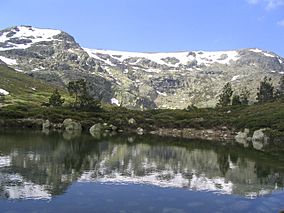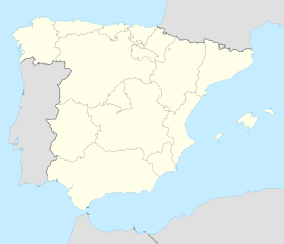Guadarrama National Park facts for kids
Quick facts for kids Sierra de Guadarrama National Park |
|
|---|---|
|
IUCN Category II (National Park)
|
|

Peñalara Peak and Peñalara glacial lagoon
|
|
| Location | Sierra de Guadarrama (Castile and León and Community of Madrid, Spain) |
| Area | 339.60 km² |
| Established | June 26, 2013 |
| Governing body | Spanish Ministry of Environment. |
The Sierra de Guadarrama National Park (in Spanish: Parque Nacional de la Sierra de Guadarrama) is a special protected area in Spain. It covers almost 34,000 hectares, making it the fifth largest national park in Spain. This park is located in the Guadarrama mountain range, which is part of the larger Sistema Central mountains. You can find it in two regions of Spain: the Community of Madrid and Castile and León (specifically in the provinces of Segovia and Ávila). The law that officially created this national park was passed on June 26, 2013.
Contents
Amazing Animals and Plants of Guadarrama
This national park was created to protect the many different natural areas found in the Guadarrama mountains. It even includes unique "high Mediterranean mountain" areas, which are rare in Spain.
Diverse Ecosystems and Species
The park is home to over 1,280 different kinds of living things. Among these, 13 species are in danger of disappearing forever. There are also more than 1,500 types of native plants and 30 different kinds of plant communities.
The animals in these mountains make up a huge part of Spain's wildlife. About 45% of all animal species in Spain live here, and 18% of all European animal species!
Plants of the Park
You'll find many types of trees and plants here. Some common ones include the Scots pine, oak trees, and juniper bushes. There are also plants like piorno and many others that make the landscape beautiful.
Wildlife of the Park
The park is full of exciting animals. You can spot many mammals like different kinds of deer (such as red deer, roe deer, and fallow deer). There are also wild boar, wild goats, and badgers. Smaller animals include mustelidaes (like weasels), wild cats, foxes, and hares.
If you look towards the water, you'll see many types of waterfowl in the reservoirs. High in the sky, large birds of prey like the majestic Spanish imperial eagle and the huge Eurasian black vulture soar. Recently, a group of wolves was found living in the park. This was exciting news because wolves had not been seen in this area for about 70 years!
How the Park Was Created
People wanted to protect the Guadarrama mountains for a long time. It took many years and a lot of effort to make it a national park.
Early Ideas for Protection
Back in the 1920s, a group called the Peñalara Mountain climbing society first suggested that the Guadarrama mountain range should become a national park. However, this idea was put on hold for many years. It wasn't until the early 2000s that the Community of Madrid started working on the project again.
Before it became a national park, some parts of the Sierra de Guadarrama already had special protection:
- Since 1984, the area around El Escorial has been a World Heritage Site. This means it's recognized as very important globally.
- The Peñalara Natural Park was created in 1990. This natural park includes important wetland areas where amphibians live. In 2006, these wetlands were given even more protection as a Ramsar site. This area is also a special place for birds.
- A regional park, called Parque Regional de la Cuenca Alta del Manzanares, was set up in the 1980s. The upper part of the Manzanares River basin within this park was also named a biosphere reserve in 1992.
Working Towards a National Park
When the idea of a national park was brought up again in the early 2000s, it was planned to be the fourth-largest in Spain. By 2006, it seemed like the park would be officially created very soon. A plan for the part of the park in the Community of Madrid was approved in November 2006.
Working with Different Regions
Creating a national park that spans across different regions can be tricky. The region of Castile and León agreed to include some of its land in the park. However, there were some delays in making their part of the plan. This was because the regional government wanted to make sure that local activities, like farming and forestry, could continue. These activities are important for the people living there, and national park rules can sometimes limit them.
Eventually, in 2009, Castile and León agreed to approve a plan for their part of the national park in 2010. The Community of Madrid also made similar plans for a slightly smaller park area. The goal was to find a balance between protecting nature and allowing traditional ways of life to continue.
See also
 In Spanish: Parque nacional de la Sierra de Guadarrama para niños
In Spanish: Parque nacional de la Sierra de Guadarrama para niños




